- What Is Web3?
- How Web 3 Is Revolutionizing Payments?
- Why Is Web3 The Future Of Payments?
- How To Make A Web 3 Payment Solution Platform?
- Top 5 Examples Of Web3 Payment Solutions
- How To Make Payments In Web3?
- How To Select A Good Web3 Financial Software Development Company?
- Tech Stack For Developing Web3 Payment Solutions
- Conclusion
- FAQ
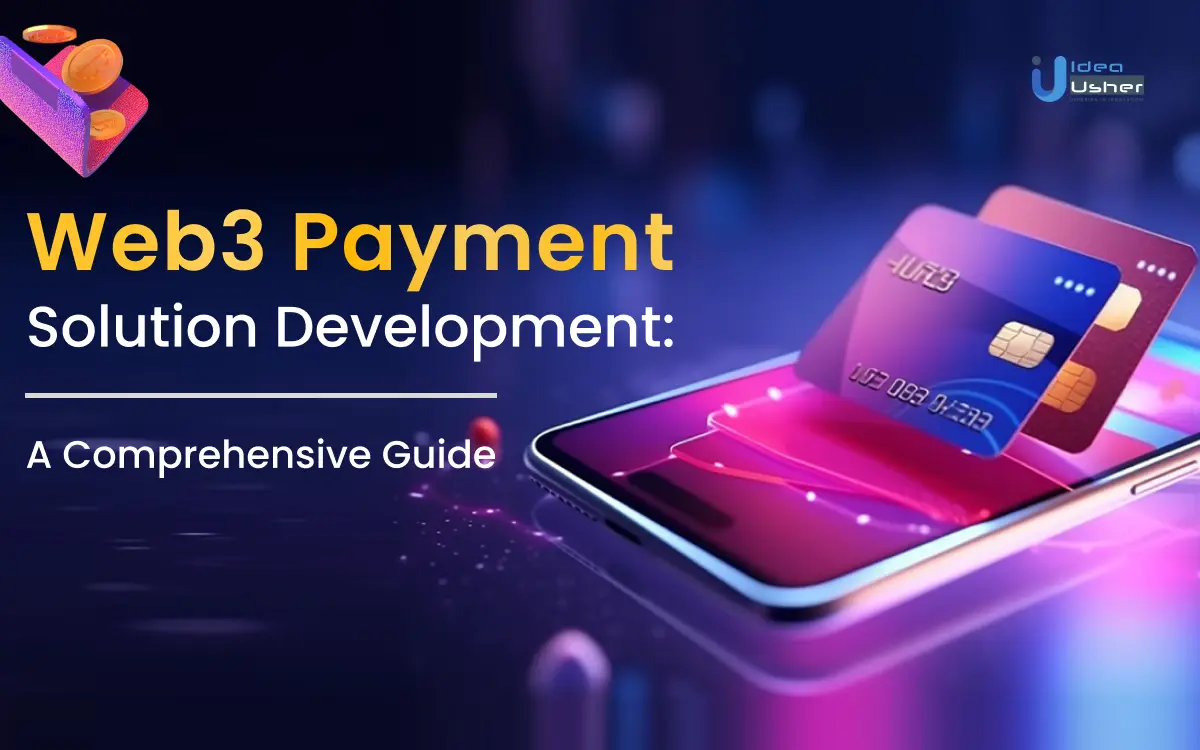
The changing habits of consumers over time are challenging many businesses to adapt and meet consumers’ new expectations.
Many businesses have realized the need to reevaluate their payment options as they offer customers more choices to spend based on their payment preferences.
Web3 payments are becoming a viable option for businesses to offer safer, smarter, and more straightforward payment options to their customers. However, developing a Web 3 payment solution requires expertise across blockchain development, app development, and other relevant areas of software development.
To simplify your Web3 payment solutions development journey, we have discussed the development steps, required tech stack, and the criteria to select the best Blockchain development company for developing Web3 payment solutions for your business.
- What Is Web3?
- How Web 3 Is Revolutionizing Payments?
- Why Is Web3 The Future Of Payments?
- How To Make A Web 3 Payment Solution Platform?
- Top 5 Examples Of Web3 Payment Solutions
- How To Make Payments In Web3?
- How To Select A Good Web3 Financial Software Development Company?
- Tech Stack For Developing Web3 Payment Solutions
- Conclusion
- FAQ
What Is Web3?
Web3 refers to a set of technologies aimed at evolving and decentralizing the current architecture of the internet and digital services associated with blockchain technology.
The primary purpose of Web 3 in payment is to reshape the internet to make it more democratic and accessible and combat a few large tech companies and their payment infrastructure due to their centralization and handling less control over their customers.
In Web 3, all the data metrics are stored in a decentralized location and network instead of relying on private companies, and all transaction information would be sent without going through a third party.
How Web 3 Is Revolutionizing Payments?
Different billing and payment options have recently increased, and various businesses have adopted some.
One of the most important new business models companies opt for in Web 3 is UBP, a usage-based pricing model that allows end users to pay only for what they consume. UBP comes as a better alternative billing model to meet the changing needs of consumers.
However, there are various complexities of UPB pricing models, such as companies need to capture various incoming data on the usage and subscriptions of their customers.
Moreover, Web 3 has revolutionized the payment space in various aspects, such as bringing decentralization and trust & transparency to their customers. Also, with Web 3, the customer can make global payments without the restrictions of any currency conversions or heavy transaction fees.
Why Is Web3 The Future Of Payments?
Web 3 offers a secure way of fund transfer via encryption, offering a protective layer of privacy where customers don’t need to share their personal data, and their transaction details are not accessible to suspicious parties.
Moreover, Web 3 eliminates the need for centralized intermediaries, another factor that enhances privacy and democratization in a world of decentralization.
Compared to Web 2 payments, the blockchain payments in Web 3 settle in minutes or even seconds, eliminating the need for currency conversion and expensive fund transfer fees. Web 3 payments involve the use of secure ledgers for processing money transfers as well, which reduces the chance of disclosing any personal information of customers, such as credit card or bank account number.
Considering the security aspect, in addition to the capability of having instant fund transfer in the absence of any currency conversion or heavy fund transfer fees, we can conclude that there will be more utilization of Web 3-based payment solutions in the future.
How To Make A Web 3 Payment Solution Platform?
Web 3 payment solution development involves a complex process that requires ongoing education and development. Moreover, it is essential to stay current with the latest blockchain technology advancements and remain competitive and compliant with changing regulations. Therefore, to simplify your development journey, it is advisable to seek guidance from blockchain experts and legal professionals to navigate the complexities of fintech and blockchain space.
Also, to develop a more secure, transparent, and efficient decentralized payment system, there is a requirement to implement Web 3.0 in payment solutions and leverage blockchain technology and decentralized applications (DApps).
Here are the steps to implement Web 3.0 in payment solutions:
1. Choose a Blockchain Platform
Ethereum is a popular choice for your payment solution. However, other platforms like Binance Smart Chain, Solana, and Polkadot are worth considering based on your specific payment gateway requirements.
2. Design Smart Contracts
Smart contracts are self-executing agreements as a form of contract directly written into code. The purpose of using smart contracts in payment solutions is to automate payment processes, escrows, governing payment processes, and more.
3. Asset Tokenization
Tokens can be utilized in blockchain payment solutions for payments, rewards, and governance for your Web 3.0 payment solution. The tokens in the blockchain platform represent the value of the particular assets within the ecosystem.
4. Wallet Integration
There are various popular wallet options for your Web 3 payment solution, including MetaMask, Trust Wallet, and Coinbase Wallet. Wallet integration to your payment solution will enable users to manage their digital assets within the cryptocurrency wallet available on your payment provider platform.
5. User Onboarding and Education
Many users are unfamiliar with decentralized applications or cryptocurrencies. Therefore, providing comprehensive, user-friendly guides and tutorials is essential for your Web 3 payment solution platform. The tutorials will help your users understand more about the decentralized-based Web 3 world and help them easily access your platform.
6. Payment Gateways
You can consider integrating payment gateways from popular third-party solutions providers such as Coinbase Commerce, Bit Pay, CoinGate, etc.
7. Security
Conduct security audits to ensure the funds of your users are protected against hacks and vulnerabilities.
Moreover, keeping your platforms safe will help you to gain your users’ trust. It will help attract more users to your platform due to the reliability and security provided by your platform to your users.
8. Testing and Iteration
After the development of the Web 3 payment solution, it is crucial to test your payment solution and gather feedback from your customers. You can improve the platform based on user input and evolving technologies.
9. Platform deployment
When your Web 3 payment solution is ready to launch, you can integrate it into your business website and mobile application. Next, deploy payment solutions to your chosen blockchain network.
9. Maintenance and Updates
Even after deploying payment solutions to your preferred blockchain network and integrating them into your business platform, it is crucial to regularly maintain and update your payment solution to address security vulnerabilities, bugs, and evolving with user needs.
Also, it is necessary to update your platform based on regulatory changes and challenges in the blockchain and cryptocurrency space.
Top 5 Examples Of Web3 Payment Solutions
In this section, we will explore the best Web 3 payment solution that facilitates their users making payments with cryptocurrencies, NFT, and other decentralized digital assets.
1. Blockonomics
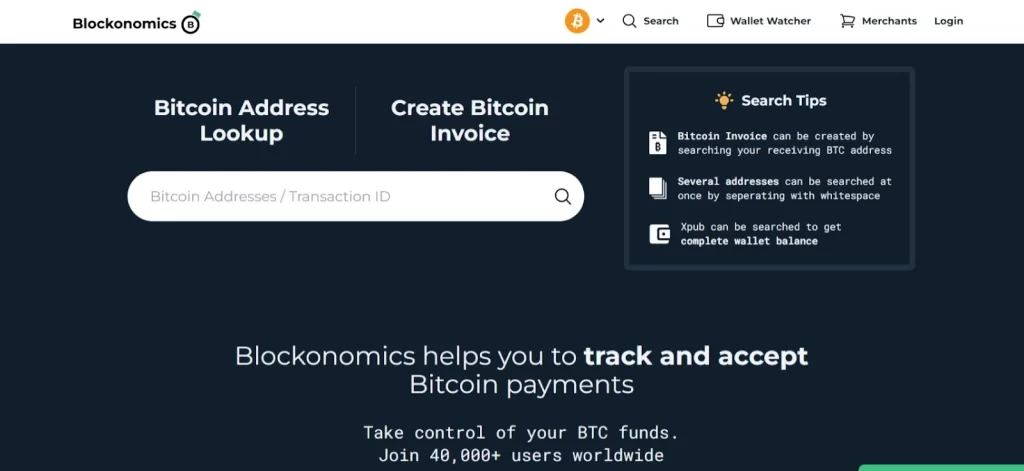
Blockonomics is a decentralized and non-custodial platform that provides an additional layer of privacy and security. Moreover, the platform offers simple shopping cart plugins and API integration for major e-commerce platforms like Wix, Shopify, WordPress, Squarespace, and more, making it easy for stores to accept Bitcoin payments.
Also, Blockonomics offers real-time price conversion options during checkout, where merchants can get paid in Bitcoin. The wallet watcher feature of Blockonomics allows merchants to track multiple addresses and wallets where users can receive email notifications after any crypto transactions.
Pros:
- Real-time conversion into cryptocurrencies during checkout.
- Blockonomics does not hold user funds.
- Streamlining the adoption of cryptocurrencies for merchants, as it provides easy-to-use plugins for major e-commerce platforms.
Cons:
- No buyer protection for transactions.
- Only supports Bitcoin.
2. CoinGate
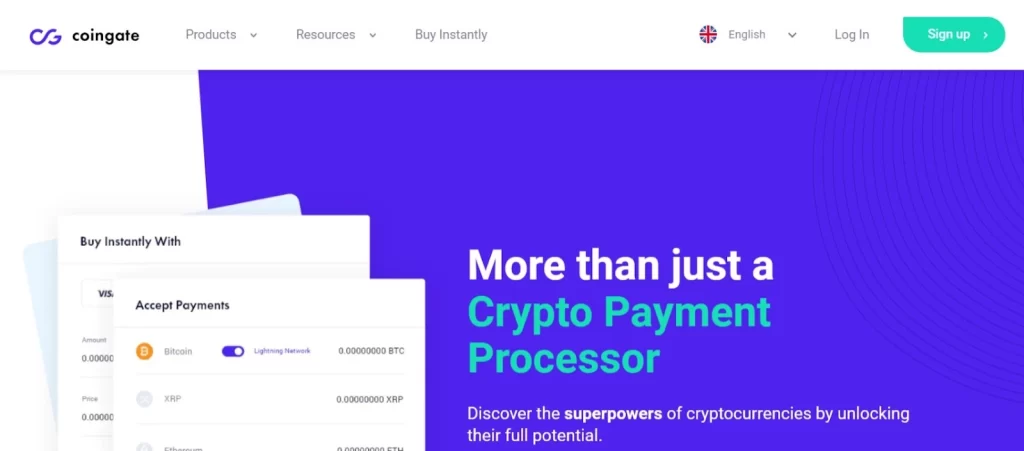
A comprehensive cryptocurrency payment gateway where merchants and individuals can easily accept, store, and spend various cryptocurrencies. CoinGate offers a range of user-friendly solutions and supports over 70 cryptocurrencies.
Coingate offers various APIs and plugins for popular e-commerce platforms like Magento and WooCommerce, simplifying the adoption of cryptocurrencies as a payment method.
Also, Coingate enables businesses to collect payments, send billing invoices, and fiat currency to crypto conversions or cryptocurrency.
Pros:
- Businesses can accept over 70 cryptocurrencies.
- Provides simple plugins for APIs and shopping carts, enabling smooth integration into existing platforms.
Cons:
- No instantaneous settlements in fiat currency, potentially affecting cash flow for merchants.
3. BitPay

Bitpay offers secure and efficient payment processing solutions for various industries, from e-commerce to charitable organizations. The platform is a widely recognized crypto payment service provider catering to merchants and consumers.
Moreover, BitPay offers a prepaid card for US citizens, allowing users to convert their cryptocurrencies into fiat and spend them at any merchant accepting debit cards.
Pros:
- Fast transactions in fiat currencies to merchants’ bank accounts on the next business day
- Allowing businesses to receive a wide range of cryptocurrencies, including 5 USD-pegged stablecoins.
Cons:
- Only settlements in fiat currencies or stablecoins.
- BitPay only accepts ERC-20 coins.
- Requires Know Your Customer (KYC) procedures for users, which may be a drawback for privacy-oriented individuals.
4. MoonPay
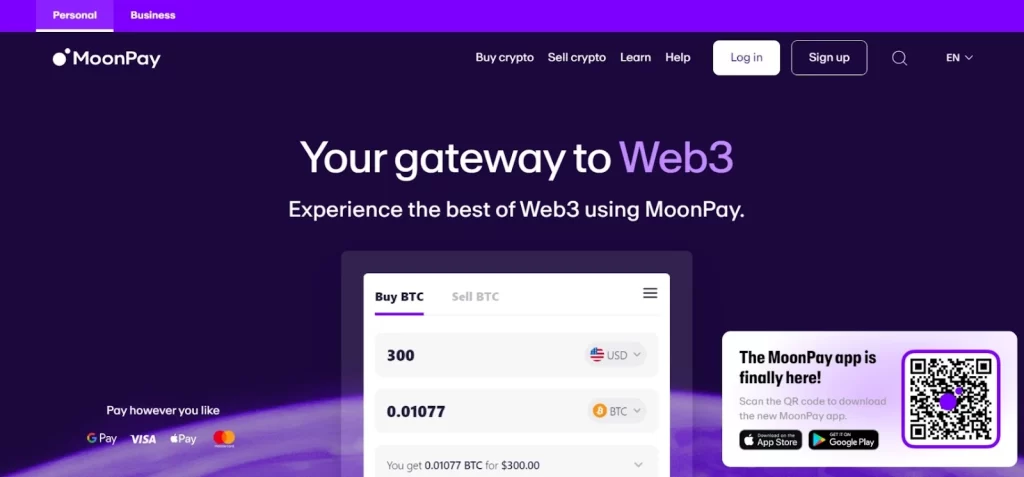
Another best crypto payment plug-and-play solution for businesses and their customers. Moonpay simplifies buying and selling cryptocurrencies by allowing businesses to integrate an express checkout widget into their websites or applications without needing specific technical expertise and skills.
Moonpay supports over 80 cryptocurrencies, allowing customers to purchase digital assets using various payment methods, including Apple Pay, Google Pay, and credit and debit cards. Also, the platform is integrated with leading platforms such as Magic Eden, Sorare, Uniswap, OpenSea, OKX, and more, where customers can purchase NFTs and crypto.
Pros:
- Offers developer-friendly APIs, enabling easy integration into websites and applications.
- All major payment methods are accepted, including SEPA, Faster Payments, Apple Pay, Google Pay, Wire Transfers, ACH, and Open Banking.
- Supports customers from 160+ countries.
Con:
- Need some technical expertise for API integration
5. NOWPayments
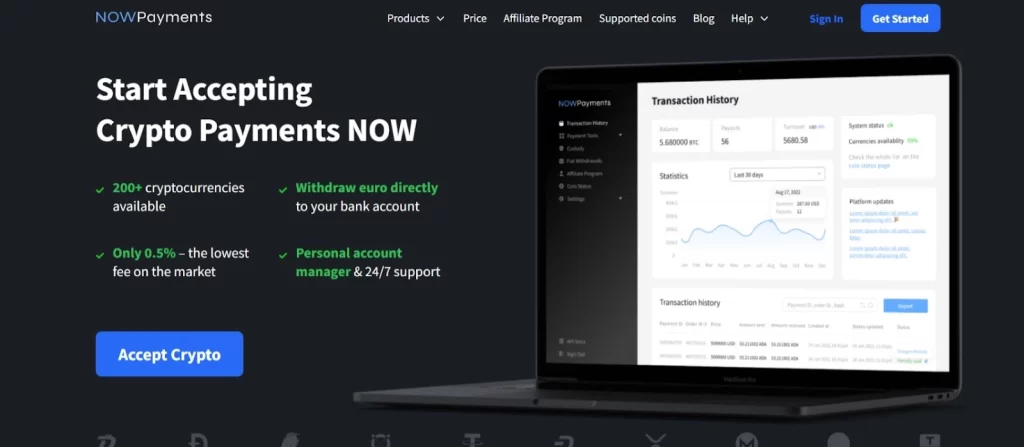
A non-custodial crypto payment gateway allows businesses to accept cryptocurrencies through various integrations. NowPayment supports over 160 cryptocurrencies, including significant options like Ethereum, Bitcoin, and Ripple.
The platform’s plugin integrates straightforwardly with popular e-commerce websites like Magneto and WooCommerce. NOWPayments also supports an option to receive payments in various cryptocurrencies or convert them to fiat currency.
Pros:
- Enhancing security and control over funds as NOWPayments does not hold user funds
- Supports over 160 cryptocurrencies.
- Personal account manager
Cons:
- Delays in transaction confirmations due to high network activity on certain cryptocurrencies like BTC
How To Make Payments In Web3?
Users can make Web3 payments in the following ways:
1. Payment using web3 wallets as browser extensions
The following steps will enable users to make payments in Web3:
- Downloading and activating the browser extension on supported browsers.
- Then user can import his existing account using its private key or create a new account.
- Next, to create a new account, users will set up the wallet’s password, which will differ from the private key.
- The wallet will display the seed phrase (which will used for restoring the account in case the user forgets his private key); therefore, the user must store the private key in a safe place.
- The user can use the blockchain networks for a Web3 payment account, e.g., Testnet, Mainnet, Devnet, etc. Also, users can add custom networks along with the local host.
- Using dApp, the users can access the estimated gas fee for that transaction. This gas fee is deducted from the native token balance (e.g., BTC for Bitcoin) of the specific blockchain network to which that wallet is associated.
2. Web 3 Wallets and SDK for making payments through dApps
Users can interact with various dApps on blockchains to access digital assets such as NFTs through Web 3 wallets.
The Web3 wallets can be accessed in different ways, such as:
- Browser Extension
- Browser wallets
- Mobile wallets (Android and iOS dApps)
In Web3 wallets, users can create their accounts to store their digital assets. A Web3 wallet account includes a pair of public and private keys where the public key is the address of that account, allowing anyone to send/transfer tokens and other assets. The public key can be shared among others without a threat to security.
Whereas the private key acts as a password that must be kept safe from others to avoid any security breach. Users can import new accounts from the same private key into a Web3 wallet.
How To Select A Good Web3 Financial Software Development Company?
Every business has different needs for Web 3 payment solution development in size, budget, target audience, and other factors. However, accessing a secure, simple, and flexible solution remains common for all businesses. Therefore, always select a company based on your business needs and long-term goals for Web 3 payment solutions.
Consider the following factors for choosing a suitable payment service software development provider for your business.
- Compare pricing models between web3 payment solutions software development providers to choose the best one for your budget.
- Ask about compliance policies to protect buyer accounts and data, in addition to figuring out how secure their payment solution is.
- Ensure the software development company has excellent security measures, including firewall or intrusion detection systems, to ensure data and financial transactions.
- Your partnered software development company must have qualified and experienced developers to receive the software with bug-free experience.
- Ensure the software development company has excellent security measures such as firewalls or intrusion detection systems to ensure data and financial transactions.
- The company you will work with must be updated with the latest technologies like JAVA, data mining, Artificial Intelligence, Machine Learning, big data, etc.
Here is a guide on how to hire blockchain developers in 2023.
Tech Stack For Developing Web3 Payment Solutions
The selection of the technology stack will depend on your Web3 payment solution’s specific requirements and use cases. Moreover, based on your platform-specific requirements and use cases, there may be some moderation for selecting an appropriate tech stack.
The general tech stack for Web3 payment solutions development is as follows:
1. Blockchain Platform
The choice of a blockchain platform is a critical decision. Consider the following options:
- Ethereum
- Binance Smart Chain
- Hyperledger Fabric
- Polkadot
2. Smart Contract Development
- Ethereum: Solidity
- Solana: Rust
3. Frontend Development
- Interface: HTML, CSS, and JavaScrip
- Libraries and frameworks: like React, Angular, or Vue.js
4. Backend Development
- Node.js
- Python
- Go
5. Development Frameworks and Tools
- Truffle
- Hardhat
- Remix
6. Decentralized Identity Solutions
- SelfKey
- Sovrin
- uPort
7. Front-End Development
- React
- Angular
- Vue.js
8. Back-End Development
- Node.js
- Express.js
- Python
9. Database Management
- MongoDB
- MySql
10. API Integration
- APIs for financial market data
- Payment gateways APIs
11. Security Measures
- Encryption
- Multi-factor authentication
- Auditing tools
12. Testing Tools
- Smart contract testing: Truffle
- Front-end testing: Jest
13. Monitoring and Analytics
- Prometheus
- Grafana
14. Compliance Framework
- KYC
- AML procedures
15. Scalability and Performance Optimization
- Sharding
- Layer-2 scaling solutions
Conclusion
By harnessing the power of blockchain technology, Web 3.0 payment solutions represent a revolutionary shift in digital transactions.
The decentralized networks and cryptocurrencies offer numerous advantages to payment solutions, including increased security, reduced fees, and enhanced transparency.
However, it is crucial to prioritize user education and user-friendly interfaces to bridge the gap between traditional financial systems and the Web 3.0 ecosystem.
Therefore, working with reliable blockchain development is a way to ensure the long-term success of your payment solution, as the company will maintain a strong focus on security, compliance, and scalability and will help you eventually expand the reach and functionality of your solution.
You can contact our team if you are looking for blockchain development experts who can ensure the success of your Web3 payment solutions from its ideation to launch on your preferred blockchain network.
Our team of blockchain experts will efficiently handle your Web 3 payment solution project to help you easily accept cryptocurrencies and other decentralized digital assets from your customers on your business platform. Also, you can provide your Web 3 payment services to other businesses and generate revenue on each transaction.
Contact us today to learn more about how we can help you with the web3 payment solutions development.
FAQ
Q. What is the Web3 payment system?
A. Web3 payments are decentralized, unlike traditional online transactions, which means that no single entity does not control them. Moreover, transactions take place on a distributed ledger maintained by computer networks, which makes it virtually impossible for any one person or organization to break into a ledger or steal funds.
Q. How do Web3 payment services work?
A. Web3 payments allow users to interact with dApps across different blockchains, which can be used to store digital assets such as cryptocurrencies & NFTs through web 3 wallets.
Q. What are the best blockchain payment systems?
A. Blockonomics, CoinGate, BitPay, MoonPay, and NOWPayments are some of the best blockchain payment systems.













Gaurav Patil